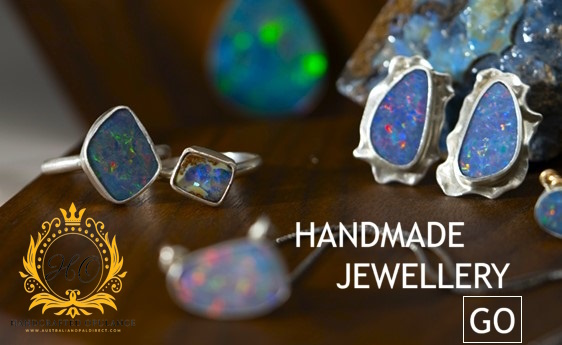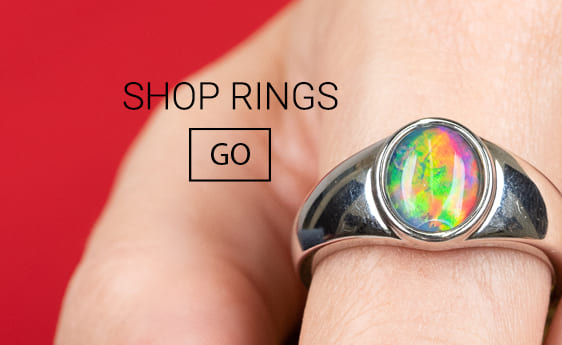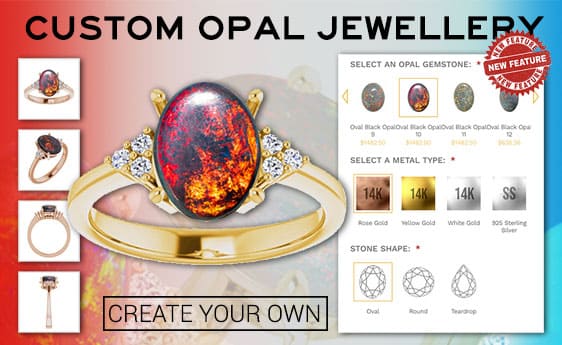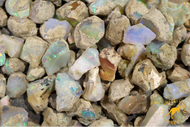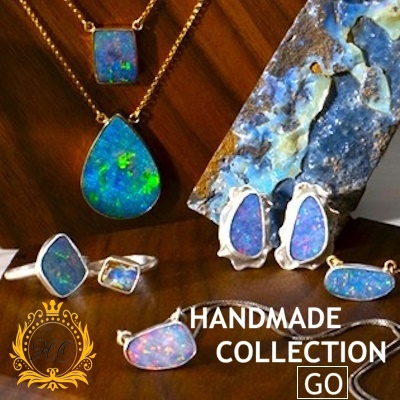What Are the Different Types of Opal?
Posted by Australian Opal Direct on 4th Nov 2023
Delving into the captivating world of Opals reveals a spectrum of diversity and beauty akin to a visual symphony. These precious gems are cherished for their distinct color play, with each stone holding a universe within.
The Opal, with its ethereal charm and varied types, serves as a powerful conversation piece, speaking volumes about the wearer's refined taste and appreciation of uniqueness. In this article, we will explore the myriad kinds of Opal stones, each with its own tale and an allure that promises a journey of luxury and elegance.
A Word on Opal Terminology
Natural Opals
Natural Opals, as the name suggests, are Opals in their purest form, untouched by human intervention. Born deep within the earth, these Opals took millions of years to form inside the earth and are the result of a complex process involving silica and water.
You can often find a natural Opal nestled within a matrix or host rock, its magical play of color a result of the structure and arrangement of tiny silica spheres within the stone

Precious Opals

Precious Opals are the epitome of luxury and elegance. They exhibit a mesmerizing play of color, or "Opal fire," that changes with the angle of observation. This stunning optical phenomenon is a result of light diffracting and interfering with the microscopic spheres of silica present in the stone.
Highly sought after for their unique beauty, precious Opals often serve as the centerpiece of extravagant jewelry pieces that enable the wearer to make a bold statement of both individuality and sophistication.
Common Opals
Don't let the term "common" mislead you about the common Opal. While they may not display the flashy play of color that is characteristic of precious Opals, common Opals have their own understated charm and beauty.
Common Opals, often referred to as “Potch Opals,” offer an affordable alternative for those seeking to incorporate the mystical allure of Opals into their jewelry collection without sacrificing quality or uniqueness

Solid Opals, Opal Doublets, and Opal Triplets

Solid Opals are undeniably enchanting, encapsulating the raw beauty and authenticity of these treasured gems. Unlike doublets or triplets, solid Opals are crafted from a single piece of Opal and are not layered or combined with other materials. This means that the vibrant play of color you see radiates entirely from the Opal itself, unembellished and unaltered by human hands.
The organic charm of solid Opals, coupled with their high quality and uniqueness, make them a highly desirable choice for those seeking a piece of jewelry that evokes elegance and luxury in its most unadulterated form.
Opal doublets and triplets, meanwhile, offer a clever way to enjoy the vibrant color play of precious Opals at a more accessible price point. An Opal doublet consists of a slice of precious Opal adhered to a backing, typically made from ironstone or black potch, which enhances the Opal's color and provides additional strength.
Meanwhile, an Opal triplet adds another layer to the doublet: a clear cap of quartz or glass. This not only protects the precious Opal but also amplifies its color, creating a deep and mesmerizing effect. Both the doublet and triplet allow for a broader range of Opal jewelry, making these luxurious and unique gems accessible to a wider audience.
Factors That Determine the Type of Opal
The classification of Opal types is an intricate process governed by an array of factors that contribute to the stone's unique character and charm.
Play of Color
First among these is the color of the Opal, a mesmerizing display of hues that dance and gleam beneath the surface of the gem. The color spectrum of Opals can range from fiery oranges and reds to cool blues and greens, each color reflecting a different facet of the gem's personality.
Pattern
Next, the pattern of an Opal also significantly influences its classification. This pattern determines the arrangement and flow of colors within the Opal, creating a visual spectacle as unique as a snowflake. These patterns can range from pinfire (small specks of color) to broad flash (large swaths of color that cover the stone's surface).
Body Tone
The body tone refers to the base color of the Opal and is another crucial factor in determining the type of Opal. An Opal's body tone can vary from dark, such as black or dark gray, to light, such as white or crystal. The body tone serves as a canvas for the play of color, enhancing or muting the colors depending on their intensity.
Brilliance
Brilliance, or the measure of brightness and color intensity, is an equally essential element in assessing an Opal's quality and type. A brilliant Opal will exhibit vibrant, rich colors even in low light conditions, making it a prized possession among Opal enthusiasts.
Transparency
Lastly, transparency is a distinguishing factor in Opal types. A translucent Opal allows light to pass through it, which enhances the color play. On the other hand, a solid Opal reflects light from the surface, offering a different yet equally enchanting display of colors.
The Symphony of Opal Types
Now that we have unearthed the factors that contribute to the unique character of each Opal, it's time to embark on an exploration of the different types of this enchanting gem. The world of Opals is as varied and diverse as a painter's palette, each type of Opal stone offering a distinct blend of color, pattern, and brilliance.
Whether it's the fiery hues of a red Opal, the calming tones of a blue one, or the celestial beauty of a crystal Opal, each Opal type holds a universe of visual delight within its heart.
As we journey through each Opal type, you will find a gem that resonates with your personality. A gem that is not just a stone, but a piece of the universe's story etched in an Opalescent hue.
Boulder Opal

The second-most precious type of Opal is Boulder Opal, the rugged beauty and resilience of which is indeed a marvel among the Opal family. Formed within the crevices and cavities of ironstone boulders, it is a testament to the magical artistry that lies in the heart of nature.
The process of its formation is an extraordinary one. Over countless years, silica-rich water seeps into the voids of these ironstone boulders and hardens, forming Opal. When the Opal is cut along with the ironstone host, the result is a stunning Boulder Opal, characterized by vibrant veins of Opal coursing through a matrix of earthy ironstone.

A fun thing about Boulder Opals is that because the vein of Opal that forms within the ironstone is so thin, Boulder Opals need to retain an ironstone backing in order to be large enough for a full-sized stone. The result is an Opal that looks like a doublet but is actually all-natural!
The formation of boulder Opal occurs exclusively in the Opal fields of Queensland, Australia. These Opals are renowned for their durability and unique aesthetic appeal. The ironstone matrix in which the Opal forms not only provides strength to the gem but also accentuates its color play, creating a dramatic contrast between the vibrant Opal and the dark ironstone background.
The spectrum of colors exhibited in a boulder Opal can range from the full rainbow spectrum to specific colors, with patterns that are as varied as nature itself.
Black Opal
Possessing an allure as deep and mysterious as the night sky, the black Opal stands as a beacon among the array of Opal types. It is the crown jewel of the Opal family, revered for its dark body tone which offers a magnificent canvas for a dazzling play of colors.
This nocturnal beauty gets its name not from the color spectrum it displays, but from its black body tone, which is caused by natural impurities (such as iron oxide and carbon present) that were present during formation. Mined primarily in Lightning Ridge in Australia, black Opals are known for their striking brilliance and color intensity, often exhibiting a spectacular rainbow of colors that dance and shimmer with every movement.

Part of the allure of Black Opals lies in their rarity, which is a result of a unique formation process that requires a precise set of geological conditions. The need for a particular mix of conditions and elements, including the right temperatures, pressure, and amount of silica, makes the natural creation of a Black Opal a rare event indeed, contributing to its status as one of the most coveted gemstones.
White Opal

White Opal, often referred to as "milky Opal," is an enchanting variety of Opal that exudes a sense of serenity and elegance. Unlike the striking darkness of the black Opal, the white Opal is renowned for its light body tone, ranging from translucent to semi-translucent with a pale white or light cream base.
This softer body tone provides a delicate canvas for the vibrant color play that Opals are known for, creating a harmonious blend of subtlety and vibrancy.
Hailing predominantly from the Opal fields of Coober Pedy in South Australia, the white Opal dazzles with a more muted yet equally fascinating play of colors. It exhibits a broad spectrum of hues, from pastel blues and pinks to vibrant greens and yellows, providing a softer, more romantic display of opulence.
While all precious Opals are rare as far as gemstones go, white Opal is perhaps the most abundant. This type of gem is a great choice if you want to get started in building up your Opal jewelry collection.
Crystal Opal
True to its name, crystal Opal is a transparent to semi-transparent variety of Opal that mesmerizes with its clear or light body tone, allowing for a stunning display of spectral delight. Its transparency serves as a window into the gem’s soul, allowing the observer to lose themselves in the iridescent depths of the Opal’s color play.
Originating primarily from Australia (especially South Australia and New South Wales), crystal Opals can display any color in a variety of patterns. Their beauty is amplified by the light that passes through them. The interplay of color and light in a crystal Opal creates a breathtaking spectacle, akin to gazing into a kaleidoscope of shifting hues and patterns.

Perhaps the most famous example of a Crystal Opal is the Andamooka Opal, also known as “the Queen’s Opal.” This Opal had been discovered in the Andamooka fields of South Australia in 1949 and was set within a 200-carat necklace, which was then presented to Queen Elizabeth II by jeweler John Altmann as a token of loyalty and admiration during her 1954 tour of the South Australian region.
Blue Opal

Blue Opal, often referred to as the "Gem of the Gods," captivates with its tranquilizing azure hues that are reminiscent of serene ocean depths. This Opal type is distinguished by its soothing spectrum of color, varying from sky blue to deeper shades of marine blue.
The charm of a blue Opal lies in its serene play of color, which offers a calming and peaceful vibe compared to the vivacious color palette of other Opal types. Blue Opal owes its captivating color to the silica spheres within the gem. The color we perceive is the result of light diffraction caused by these tiny silica spheres.
When the spheres are closely packed and of a similar size, they diffract light to give the opal its vibrant blue color. This phenomenon, known as Bragg's Law, makes blue opals a spectacular sight to behold. Their beautiful blue tones, ranging from sky blue to deep sea blue, mirror the vastness of the oceans and the tranquility of the skies.
Predominantly found in Peru (where it was named the national stone!) and US states such as Oregon, Nevada, and Idaho, blue Opals are a testament to the beauty and diversity of the Opal family.
Matrix Opal
Matrix Opal is a unique member of the Opal family that truly stands out for its distinctive charm and allure. Living up to its name, the matrix Opal is an Opal type where the precious Opal is intimately diffused as pinpoints, veins, or networks within a host rock (typically ironstone or sandstone), forming an inseparable unity of color and form.
In other words, the host rock “breaks into” the body of the gemstone. This unique formation results in a fascinating display of colors, where the vibrant hues of the Opal are intricately woven within the earthy tones of the host rock, thereby creating a unique and stunning visual tapestry. It also makes matrix Opals slightly harder than other types of Opal, a strength provided by the host rock.

Sourced from Andamooka, South Australia, matrix Opals are celebrated for their durability and distinctive aesthetic appeal. Their color play is unpredictable and diverse, making each matrix Opal a unique work of art. The presence of the host rock not only enhances the gem's durability but also adds an element of depth and complexity to its color display.
Fire Opal

Fire Opal, often referred to as the sunstone, commands attention with its intense shades of red, orange, and yellow. Predominantly sourced from Mexico, fire Opals are a testament to the raw power and breathtaking beauty that lies in the heart of our planet. In ancient times, the Mayan and Aztec peoples called fire Opals “quetzalitzlipyollitli,” which means “the stone of the bird of paradise.”
The formation of this spectacular Opal type is a marvel of nature. Unlike other types of Opals that are sedimentary in origin, fire Opals are formed in the fiery depths of volcanoes. As lava from volcanoes cools, water in the lava becomes trapped within the mineral structure.
Over time, silica spheres form around the trapped water droplets, creating the array of fiery colors that characterize the fire Opal. This volcanic birth gifts fire Opal with its uniquely intense and vivid hues, reminiscent of a sunset or the dancing flames of a fire.
How to Choose the Right Opal for You
Choosing the right Opal for you is a journey of personal discovery. It's a dance between your personal style, the Opal's unique characteristics, and the ethics of its source.
Here are some tips to help you find your perfect Opal gemstone match:
-
Consider Your Style: Different types of Opals resonate with different fashion styles. For example, if you're drawn to vibrant and dramatic pieces, a fire Opal with its warm hues might be your ideal choice. Conversely, if you prefer understated elegance, you might find the pink Opal with its tranquil charm more appealing.
-
Think About Your Color Palette: Consider the colors you typically wear. If your wardrobe leans towards warm tones, a fire Opal could be an excellent complement. For neutral or earthy colors, a matrix Opal might be a better fit. If you love pastel shades, the Peruvian Pink Opal could be just the gem for you.
-
Quality and Ethical Sourcing: Always ensure that the Opal you choose is of high quality, is ethically sourced, and is accompanied by a certificate of authenticity. This not only guarantees that you're investing in a gem that is as genuine as it is beautiful, but it also ensures that it has been obtained with respect for the earth and its inhabitants.
-
Uniqueness and Luxury: Each Opal type offers its own sense of luxury and elegance. Choose the Opal that not only matches your fashion sense but also acts as a conversation piece that showcases your unique taste.
-
Listen to Your Intuition: Lastly, as the expression goes, trust your gut! As you explore different Opal types, pay attention to which gem "speaks" to you.

Conclusion
In the search for the perfect Opal, the journey is as enchanting as the destination. Each Opal type, with its unique formation, color display, and story, is a testament to nature's artistry and an invitation to express your individual style.
Australian Opal Direct takes immense pride in providing high-quality, ethically sourced Opals, each of which carries a unique story waiting to be shared. As you embark on your journey of Opal discovery, we are here to guide you as you celebrate the allure and individuality that each type of gemstone brings to your life.

